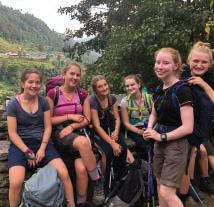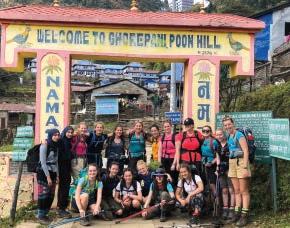
7 minute read
International Trips - Nepal
Nepal October 2019
October 2019 saw two teams of students head off to Nepal with four members of staff to go on an adventure we will all remember for a lifetime.
On our arrival in Kathmandu we hastily checked in to our hotel and jumped back on a bus to visit the WWF Headquarters for the Asia region. Although extremely tired from our travels we listened to a fascinating talk about how WWF distributes its resources in the area, particularly focusing on reducing plastic waste and protection of endangered species such as the tiger. Some members of the team who want to study conservation in the future asked probing questions to drill down into the information further.
After a well-earned rest, the next morning we set out to explore the bustling, chaotic city of Kathmandu. We headed to Boudhanath Stupa, one of the largest in the world, to learn about the rituals and culture of the Tibetan Buddhist Monks and have our own blessing inside the temple, where we were each presented with a yellow protective cord placed around our necks to keep us safe during our travels. I am still wearing mine one year on! After having time to explore the area we left the serenity of the stupa and headed out into the busy streets of Durbar Square, the religious centre for the Hindus. We explored the temple complex and saw the damage inflicted by the earthquake in 2015. We went to the living goddess’s temple in the hope of capturing a brief glimpse of the current Kumari, but we were unlucky on this occasion. We headed back into the narrow alleyways crowded with mopeds and people rushing around to buy everything from vegetable to copper pots, interspersed with the small Hindu shrines scattered throughout.
The next morning, we set off on a very long bus journey on very bumpy roads to Pokhara, our base for the next part of the trip. Here the two teams headed off in different directions, one to start their trek to Poon Hill and the other to teach at Shree Bhagawati Primary School.
My group headed off to the school first. I was very excited to be going there as I discovered it whilst trekking in the region many years ago and have kept in touch ever since. I couldn’t wait to see St George’s students work with the children from the area teaching each other and having fun. On our arrival the students of the school lined up to present us with garlands of flowers and then quickly St G’s students split into small groups to teach the children songs, games and ceilidh dancing! Before long any nervousness disappeared and both groups of students were having a great time together. The next few days flew by, we taught English, maths, science and geography to the students as well as helped some older students tidy up the coffee plantation belonging to the school. The coffee helps to fund equipment for the school, and we bought a lot to bring back home as presents. Our other main task was to help move rocks for the local people to build a platform at the side of the school to create an outdoor nursery area, which was a tough job in the
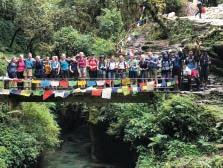
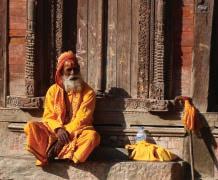
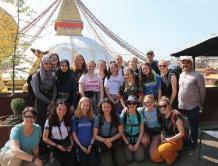

heat of the sun. Our time here had come to an end, there wasn’t a dry eye amongst us as we said our goodbyes before we headed back to our base at Tashi-Ling Tibetan Refugee Camp.
Tashi-Ling is a very special corner of Pokhara. It is a haven for Tibetan refugees who crossed from Tibet in the 1950s as they were pushed out of their homelands and crossed the Himalayas to find safety and a new life. Sonam, our host, had organised for us to stay in the community hall where the local ladies looked after us, cooking beautiful food for all our meals. We learnt to make momos and played with their children in the evening, and got up early in the morning to sit with the monks during their morning prayers. Sonam remembers leaving his homeland when he was about six and told us how he came to end up in the camp. Although his life has been very hard, he can see many positives from these unfortunate events: he has been educated and is a key member of society in Tashi-Ling, where he helps to teach travellers and tourists about the plight of the refugees. He also explained how he still feels homeless. Although Nepal has taken in many refugees, they do not have Nepali citizenship, they cannot work outside of the Tibetan community and have no passport so cannot travel. On our last evening there we exchanged cultural experiences. The ladies donned their traditional costumes and sang and danced for us, then it was our turn! We had singing in Gaelic and duos with the chanter rather than from bagpipes and the main event was ceilidh dancing - the ladies had never experienced anything quite like it!
Before we left to head out on our trek, we visited the Gurkha Welfare Trust who spoke about the work they do in looking after ex-Gurkhas and their widows both in remote communities and in a care home in Pokhara. Their work includes providing water taps for villages and sanitation blocks to keep their communities healthy. The second talk we had, we all found shocking. Women’s menstruation in remote villages is seen as a disease and the women are cast out from their homes to stay in menstruation sheds that lack any facilities or comforts until it has ended. It is believed that if a woman stays at home during her period then bad things may happen to the community such as failed crops or earthquakes. The Gurkha Welfare Trust is attempting to educate these communities and provide basic sanitary care for the women, but it is a hard-fought battle at the moment.
Then it was our turn for Poon Hill! After driving through the dramatic landscape to our start point in the foothills of the Annapurna mountains, we set off early on undulating trails through small villages crossing over rampaging rivers
on ‘interesting’ bridges to explore the mountains. Our porters carried our kitbags, three tied together with rope balanced across their foreheads as they elegantly moved through this wild terrain. We hiked, with a little less style, learning Sherpa songs from our guides and looking out for the unusual bird life and the occasional monkey hiding high up in the trees. On the morning of our summit attempt of the panoramic viewpoint on top of Poon Hill we set off at 4am, with our headtorches lighting the way as we trekked up the steep path to the top of the hill to see the sunrise. We arrived as daylight hit the tops of the mountains and we were able to see the stunning and spectacular peaks of Gangapurna, Annapurna South, Annapurna I, Dhaulagiri and Hiunchuli Mountains. After taking a lot of photos we headed down to our tea house to get some well-deserved breakfast. Later we continued on our trek past huge waterfalls, down into jungle-like gorges towards our end point, Ghorepani.
After one last evening in Pokhara we started our return journey to Kathmandu where we arrived late in the afternoon. We only had a short time left, where we did some serious retail therapy, exploring a shop run by a women’s co-operative where we learnt about their determination to start their own business and make their own products ranging from scrunchies to luxury scarves and wraps. These women were breaking away from the traditional roles expected of them and were committed to working for themselves. We spent time in the Thamel area, exploring the alleyways and refining our haggling techniques buying elephant trousers, friendship bracelets and other reminders of our trip.
Our last evening was spent at the famous pizza restaurant ‘Fire & Ice’, a well-known spot for backpackers and climbers alike, where we had our first taste of western food before heading home.
One last treat, a visit to Kopan Monastery where Sister Karen showed us around and explained how it worked. She led us through some meditation exercises and answered any questions we had about life in the monastery and that of a monk or nun. We left feeling relaxed and calm, ready to have a spot of lunch before heading to the airport to start the journey home.
I can honestly say that for all the teachers and leaders on this adventure, we all had the time of our lives. Watching this group of young people work together, engage with charities and teach at the school filled us with such pride that it genuinely brought tears to my eyes daily. Watching them experience a new culture with wonder and awe will stay with me for a very long time. Jo Mushat


